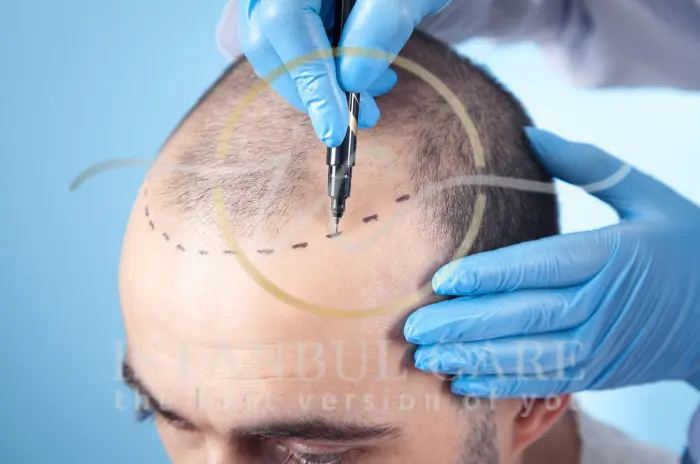Olive oil has been used for centuries as a beauty staple across Mediterranean and Middle Eastern cultures. In hair care, it is prized for its rich blend of vitamins, fatty acids, and antioxidants that naturally nourish, protect, and repair the hair and scalp. Its versatility and effectiveness in treating dryness, frizz, breakage, and scalp issues have made it a key component in both traditional remedies and modern hair routines.
Whether used as a deep conditioning mask, a pre-wash scalp treatment, or a quick fix for flyaways, olive oil helps restore balance, softness, and shine to the hair. Its growing popularity in hair care is not just a trend it’s backed by its deeply moisturizing, protective, and soothing properties that make it suitable for a wide range of hair types and concerns.

What Is Hairline Transplant Surgery?
Hairline transplant surgery is a specialized cosmetic procedure that aims to restore a natural and youthful hairline using advanced surgical techniques. Often performed on individuals experiencing hairline recession or uneven forehead-to-hairline balance, this treatment involves transplanting healthy hair follicles from donor areas (typically the back or sides of the scalp) to the front hairline area.
How Does a Hairline Transplant Work?
The process begins with a consultation and hairline design, followed by extraction of grafts and precise placement along the hairline. Techniques such as Follicular Unit Extraction (FUE) or Follicular Unit Transplantation (FUT) are used, depending on the patient’s needs and hair type.
- FUE: Individual follicles are harvested and implanted.
- FUT: A strip of skin is removed, and follicles are dissected under a microscope.
Both methods aim to deliver natural-looking and long-lasting results.
FUE vs. FUT for Hairline Restoration
| Feature | FUE (Follicular Unit Extraction) | FUT (Follicular Unit Transplantation) |
| Scarring | Minimal dot scars | Linear scar at donor area |
| Healing Time | Faster, less invasive | Slightly longer recovery |
| Suitability | Ideal for smaller hairline areas | Better for dense, large transplants |
| Cost | Typically more expensive | More affordable in some cases |
What Are the Signs of a Receding Hairline?
How to Recognize a Thinning Hairline
A receding hairline may start subtly but becomes more noticeable over time. Early indicators include:
- The hairline begins to move backwards, creating a higher forehead.
- Noticeable temple recession, often forming an ‘M’ or ‘V’ shape.
- Thinner and finer hairs appear near the hairline and temples.
- A visible contrast between the hairline and denser regions behind it.
- Frequent need to change hairstyles to conceal thinning areas.
These changes may affect personal confidence, especially when hair thinning alters facial framing and expression.
When to Consider a Hair Transplant
You may want to consider a hairline transplant if:
- Hair loss negatively impacts your self-esteem and social comfort.
- Styling options no longer conceal the receding areas.
- Your hairline has remained stable (i.e., no rapid loss) for 6–12 months.
- Over-the-counter treatments or topical solutions have shown limited improvement.
- You seek a long-term, low-maintenance solution for hairline enhancement.
A consultation with an intermediary organization can help assess your eligibility and design a treatment plan tailored to your facial structure and expectations.
Signs You Might Need a Hairline Transplant
- Age 25 or older with stabilized hair loss
- Sufficient donor hair at the back or sides of the scalp
- Realistic expectations about density and hairline shape
Hair Transplant for Men vs. Women
- Men: Usually experience an M-pattern recession and can achieve a defined and structured hairline.
- Women: Often have diffuse thinning, requiring a softer, natural-looking approach.
When a Receding Hairline Becomes a Concern
- Emotional or psychological impact
- Early-onset male pattern baldness
- Difficulty maintaining current hairstyle
The Hairline Transplant Procedure: Step by Step
Consultation & Hairline Design
- In-depth discussion of expectations and goals
- Design of a custom hairline that fits facial proportions
- Assessment of donor area quality
Extraction & Graft Placement
- Administering local anesthesia
- Extraction of healthy follicular units
- Precise placement of grafts to mimic natural direction
- Creating density at strategic points for symmetry
Recovery & Aftercare Tips
- Minor redness and swelling in the first few days
- Avoid physical activity, direct sun, and sweating
- Use prescribed sprays and gentle shampoos
What Are the Potential Benefits?
More Balanced Facial Proportions
- A lower or better-framed hairline enhances overall aesthetics
- Creates harmony between forehead, eyes, and cheekbones
Permanent Hairline Reduction
- Unlike temporary solutions (fibers, concealers), transplants are long-term
- Once healed, the transplanted follicles behave like natural hair
Feminization in MTF Patients
- Hairline surgery is often part of gender-affirming facial procedures
- Can produce a soft, rounded, and more feminine hairline
How Long Until You See Full Results?
While hairline transplant results vary by individual, there’s a general timeline most patients can expect:
- Weeks 1–2: The transplanted area may show some redness, scabbing, and slight swelling. Shedding of transplanted hairs begins.
- Weeks 3–6: Shedding continues, which is completely normal. The follicles enter a resting (telogen) phase.
- Months 3–4: New growth starts to appear, often as thin and fine hairs.
- Months 5–8: Hair begins to thicken and cover more of the treated area.
- Months 9–12: The final density and appearance emerge, and hair behaves naturally with styling.
Results may take slightly longer for women or individuals undergoing simultaneous hormonal treatments.
How Natural Will Your New Hairline Look?
Modern hairline transplants are meticulously planned for anatomical accuracy and long-term naturalism:
- Custom Design: The hairline is tailored to the individual’s facial structure, age, and gender.
- Density & Angle: Hairs are implanted at natural angles to replicate original growth patterns.
- Refinement: Especially with FUE, the small incisions and precise placement create an undetectable result.
Your new hairline will be:
- Symmetrical but soft—not unnaturally sharp
- Suited to your ethnicity and facial proportions
- Blended well into existing hair for continuity

What Happens During the Procedure?
Making Trichophytic Incisions
- A technique where the incision is made to encourage hairs to grow through the scar
- Common in FUT procedures for better scar concealment
Removing Skin and Advancing Scalp
- In hairline lowering surgery (forehead reduction), a portion of the forehead skin is removed
- The scalp is advanced downward to meet the new hairline
Combining With Brow Lift
- Often paired with upper facial surgery
- Results in both aesthetic and youthful enhancement
Hairline Transplant Cost & Factors Affecting Price
| Factor | Impact on Cost |
| Number of Grafts | More grafts = higher cost |
| Surgeon Experience | Renowned specialists may charge more |
| Technique Used | FUE is generally more expensive than FUT |
| Location & Facility | Costs vary by city, country, and intermediary organization |
Is a Hairline Transplant Worth the Investment?
- Consider the long-term benefits vs. ongoing costs of temporary solutions
- Psychological and social confidence boost
- Permanent solution to a visible concern
Financing & Payment Options
- Many intermediary organizations offer installment plans or financing
- Some patients use medical credit or health tourism packages
What Results Can You Expect?
How Long It Takes to See Final Results
- Full results typically develop in 9–12 months
- Hair becomes thicker and denser over time
Achieving a Natural-Looking Hairline
- Proper angling and density placement during surgery
- Skilled surgeons ensure the hair doesn’t appear “plugged” or artificial
Hair Growth Timeline After Surgery
| Timeline | What to Expect |
| 0–2 weeks | Healing and crust formation |
| 2–4 weeks | Shedding of transplanted hair |
| 3–6 months | Initial regrowth (thin, fine hairs) |
| 6–9 months | Thickening and increased density |
| 12+ months | Final results, full integration |
Are There Risks or Side Effects?
Common Side Effects After Surgery
- Swelling of forehead and around eyes
- Temporary numbness or tightness
- Crusting and redness
How to Minimize Risks During Recovery
- Follow aftercare instructions strictly
- Sleep with head elevated for 3–5 days
- Avoid direct sun exposure, saunas, and intense workouts for 2 weeks
Recovery and Aftercare Tips
What to Do in the First Few Days
- Apply cold compress to forehead (avoid grafts)
- Use saline sprays to keep grafts moist
- Avoid touching, scratching, or washing scalp aggressively
Long-Term Care for Lasting Results
- Use gentle, sulfate-free shampoos
- Avoid smoking and excess alcohol, which impair healing
- Take prescribed supplements like biotin or zinc (if recommended)
When to Contact Your Intermediary Organization
- Excessive swelling or bleeding
- Signs of infection (pustules, fever, pus)
- Graft dislodgement or injury to the treated area
Speak with our expert Hair Transplantation specialists

Speak with our expert Hair Transplantation specialists
We’re ready to answer your questions
Frequently Asked Questions
FUE involves extracting individual follicles with minimal scarring, while FUT removes a strip of scalp tissue to harvest grafts.
Look for a progressive backward movement of the hairline and thinning near the temples. Consider a transplant if non-surgical options no longer help.
Hairline transplant surgery involves relocating healthy hair follicles to the front of the scalp to correct recession and create a natural-looking hairline.
eople with stable hair loss, sufficient donor hair, and realistic expectations.
Recovery includes mild swelling and redness. Aftercare involves gentle cleansing, moisturizing sprays, and sun avoidance.
It takes 9–12 months for final results, which appear natural when performed by skilled professionals.
Number of grafts, surgeon’s skill, technique used, and geographic location.
Yes, including swelling, temporary numbness, and minor scabbing—all manageable with proper aftercare.

